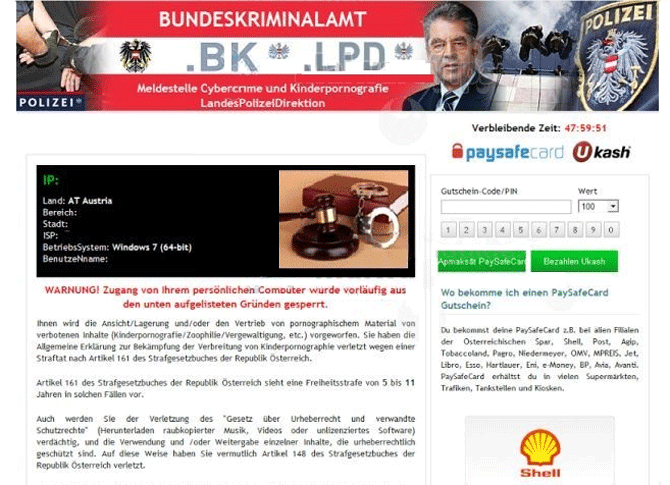'Meldestelle Cybercrime und Kinderpornografie' Ransomware
Threat Scorecard
EnigmaSoft Threat Scorecard
EnigmaSoft Threat Scorecards are assessment reports for different malware threats which have been collected and analyzed by our research team. EnigmaSoft Threat Scorecards evaluate and rank threats using several metrics including real-world and potential risk factors, trends, frequency, prevalence, and persistence. EnigmaSoft Threat Scorecards are updated regularly based on our research data and metrics and are useful for a wide range of computer users, from end users seeking solutions to remove malware from their systems to security experts analyzing threats.
EnigmaSoft Threat Scorecards display a variety of useful information, including:
Ranking: The ranking of a particular threat in EnigmaSoft’s Threat Database.
Severity Level: The determined severity level of an object, represented numerically, based on our risk modeling process and research, as explained in our Threat Assessment Criteria.
Infected Computers: The number of confirmed and suspected cases of a particular threat detected on infected computers as reported by SpyHunter.
See also Threat Assessment Criteria.
| Ranking: | 2,444 |
| Threat Level: | 10 % (Normal) |
| Infected Computers: | 8,566 |
| First Seen: | August 7, 2013 |
| Last Seen: | September 19, 2023 |
| OS(es) Affected: | Windows |

'Meldestelle Cybercrime und Kinderpornografie' Ransomware Image
The 'Meldestelle Cybercrime und Kinderpornografie' Ransomware Trojan is the Austrian variant in the Urausy family of malware. There are variants in the Urausy family belonging to nearly every country in the world. Like most Police Ransomware Trojans, the 'Meldestelle Cybercrime und Kinderpornografie' Ransomware infection is used to scam inexperienced computer users with a fake message from the police. Essentially, the 'Meldestelle Cybercrime und Kinderpornografie' Ransomware Trojan is designed to take the victim's computer hostage and then demands that the victim pay a bogus police fine.
The main thing to remember about the 'Meldestelle Cybercrime und Kinderpornografie' Ransomware is that this ransomware infection has no actual connection to the police. Rather, the 'Meldestelle Cybercrime und Kinderpornografie' Ransomware Trojan is part of a well known scam that possesses multiple variants such as the 'Centre for Critical Infrastructure Protection (CCIP)' Virus, the 'Ministry of Public Safety New Zealand' Virus and the 'Grupo de Delitos Telematicos' Ransomware that are used to steal money from inexperienced computer users. Because of this, rather than following the 'Meldestelle Cybercrime und Kinderpornografie' Ransomware's instructions, ESG security researchers recommend using a reliable anti-malware application to remove the 'Meldestelle Cybercrime und Kinderpornografie' Ransomware and prevent future infections involving variants of this police ransomware infection.
How the 'Meldestelle Cybercrime und Kinderpornografie' Ransomware Trojan Scams Computer Users
The 'Meldestelle Cybercrime und Kinderpornografie' Ransomware Trojan attacks both the victim's computer and the computer user. To attack a computer, the 'Meldestelle Cybercrime und Kinderpornografie' Ransomware Trojan uses a Winlocker to prevent the computer user from accessing the infected computer. If the victim's computer is blocked by the 'Meldestelle Cybercrime und Kinderpornografie' Ransomware Trojan, it will be impossible to access files, Windows components or even the infected computer's Desktop. Windows components that would normally be useful in dealing with this situation, such as the Task Manager or System Restore, are also disabled by the 'Meldestelle Cybercrime und Kinderpornografie' Ransomware Trojan.
The main danger in the 'Meldestelle Cybercrime und Kinderpornografie' Ransomware attack is its social engineering component. Essentially, the 'Meldestelle Cybercrime und Kinderpornografie' Ransomware Trojan tricks the computer user into believing that the infected computer was used in illegal activities, especially viewing child pornography and distributing malware. The 'Meldestelle Cybercrime und Kinderpornografie' Ransomware Trojan threatens the victim with enormous fines and years of jail time unless a bogus police fine is paid through an electronic payment service such as Ukash. Of course, since the 'Meldestelle Cybercrime und Kinderpornografie' Ransomware Trojan is not actually related to the police, computer users should avoid paying this so-called 'fine'.


Submit Comment
Please DO NOT use this comment system for support or billing questions. For SpyHunter technical support requests, please contact our technical support team directly by opening a customer support ticket via your SpyHunter. For billing issues, please refer to our "Billing Questions or Problems?" page. For general inquiries (complaints, legal, press, marketing, copyright), visit our "Inquiries and Feedback" page.